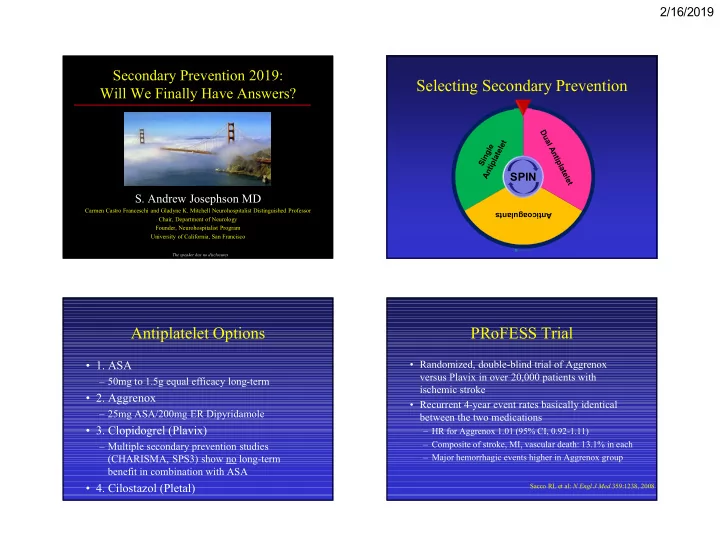

2/16/2019 Secondary Prevention 2019: Selecting Secondary Prevention Will We Finally Have Answers? SPIN S. Andrew Josephson MD Carmen Castro Franceschi and Gladyne K. Mitchell Neurohospitalist Distinguished Professor Anticoagulants Chair, Department of Neurology Founder, Neurohospitalist Program University of California, San Francisco tekhnologic The speaker has no disclosures Antiplatelet Options PRoFESS Trial • 1. ASA • Randomized, double-blind trial of Aggrenox versus Plavix in over 20,000 patients with – 50mg to 1.5g equal efficacy long-term ischemic stroke • 2. Aggrenox • Recurrent 4-year event rates basically identical – 25mg ASA/200mg ER Dipyridamole between the two medications • 3. Clopidogrel (Plavix) – HR for Aggrenox 1.01 (95% CI, 0.92-1.11) – Composite of stroke, MI, vascular death: 13.1% in each – Multiple secondary prevention studies – Major hemorrhagic events higher in Aggrenox group (CHARISMA, SPS3) show no long-term benefit in combination with ASA • 4. Cilostazol (Pletal) Sacco RL et al: N Engl J Med 359:1238, 2008 1
2/16/2019 Law of Transitivity: Antiplatelet Options Secondary Prevention • If on no antiplatelet medication • Aggrenox is better than ASA – Plavix vs. Aggrenox (or ASA) • If already on ASA • Aggrenox and Clopidogrel are equal – Switch to Plavix vs. Aggrenox • If already on Plavix or Aggrenox – ??? • Therefore, Clopidogrel is likely better than ASA Clopidogrel + ASA: Dual Antiplatelets in TIA or Minor Stroke: Ever A Winning Combination? How Long? • POINT trial • POINT was 90 days, CHANCE was 21 days • Select those with only minor or no deficits • Most recurrent events in POINT were in the first (NIHSS 3 or less or ABCD2 of 4 or more) week and over 80% were in the first 30 days • Nearly 5000 TIA or Minor Stroke patients • Hemorrhagic risk was consistent and low assigned to 90d of daily ASA + Placebo versus throughout and many were not ICH daily ASA + Clopidogrel following 600mg load • Likely it is not necessary to expose patients to a • Modestly improved efficacy (1.5%) full 90 days of increased (small) hemorrhagic risk • Minimally (0.5%) more hemorrhage Johnston SC et al: N Engl J Med 379:215, 2018 Johnston SC et al: N Engl J Med 379:215, 2018 2
2/16/2019 Shrinking Indications for When we use Dual Antiplatelets Anticoagulation in Stroke 1. Atrial Fibrillation • NOT all the time! • After minor stroke or TIA for only 21-30 days 2. Some other cardioembolic sources • After a fresh carotid or coronary stent – Thrombus seen in heart – ?EF<35 • With severe intracranial atherosclerosis (>70%) WARCEF 2012 – ?PFO with associated Atrial Septal Aneurysm and stroke/TIA in that territory for only 90 days 3. Vertebral or Carotid dissection CADISS 2015 4. Rare hypercoagulable states: APLS • Still completely unclear if there is a role for platelet inhibition testing Embolic Stroke of Anticoagulate ESUS? Undetermined Source (ESUS) • NAVIGATE-ESUS • A useful construct for strokes that appear – >7000 patients randomized to ASA or Rivaroxaban embolic (allows us to stop saying “cryptogenic”) – No benefit in efficacy, increased bleeding with Xa • 17 percent of all strokes • RE-SPECT ESUS – More likely to be younger and minor symptoms – >5000 patients randomized to ASA or dabigatran • Recurrence 4.5% per year (mean f/u 2.7y) on – No benefit in efficacy*, no increase in bleeding antiplatelet drugs • ATTICUS • A nice target for studies of other secondary – Smaller trial with apixaban pending prevention strategies Hart RG et al: Stroke 48:867, 2017 Hart RG et al: N Engl J Med 378:2191, 2018 3
2/16/2019 ESUS Subgroups that When Do We Use Anticoagulants? May Benefit? • Subclinical Afib • Atrial Fibrillation/Flutter – Monitor, monitor and then monitor again – That’s about it (currently)! • Atrial cardiopathy • Which anticoagulant to choose? – Afib does not generally occur in a healthy atrium – Prefer DOACs but remember there are some – NAVIGATE ESUS subgroup contraindications (wt >100kg, CrCl<30) – Trial pending – Meta-analysis of DOAC trials • Unrecognized MI (ventricular cardiopathy) • High dose rivaroxaban but not lower-dose or • PFO you don’t close apixaban had higher ICH risk than ASA – NAVIGATE ESUS did not show a benefit but meta-analysis previously did Huang W et al: JAMA Neurol 75:1511, 2018 What about Insulin Resistance?: Insulin Resistance in 2017 IRIS Trial • The Problem: Nearly impossible to define • Nearly 4000 patients with recent TIA or insulin resistance as they did in the trial stroke were assigned to 15mg pioglitazone • Take home: or placebo for almost 5 years – We don’t pay attention to insulin resistance • Patients did not have diabetes but were – By modifying this risk factor we could make a found to have insulin resistance reasonably big difference for our patients • Primary outcome of stroke or MI – We have no idea how to define this problem, significantly reduced in the pioglitazone but if we could, we now have guidance on how group (HR 0.71, P=0.007) to help solve it Kernan WN et al: N Engl J Med 374:14, 2016 4
2/16/2019 Insulin Resistance in 2019 • Subgroup analysis of 2885 patients in IRIS with “prediabetes” defined by ADA criteria – HgbA1c 5.7-6.4% or fasting glucose 100-125 mg/dL • Primary outcomes were similar to entire IRIS trial with hazard ratios of 0.57 (0.39- 0.84) for stroke/MI • Now we finally have a useful construct to implement IRIS in daily practice Spence JD et al: JAMA Neurol [Epub Ahead of Print], 2019 5
Recommend
More recommend